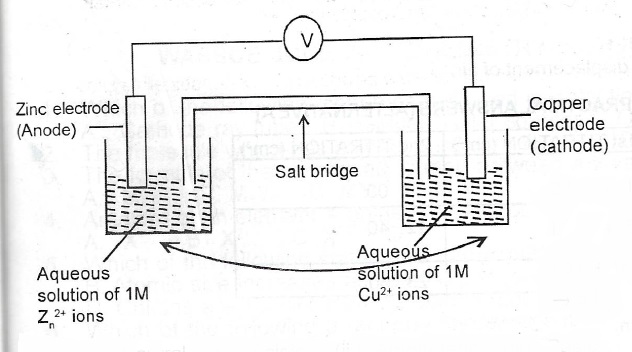(a) (i) Define standard electrode potential.
(ii) State two factors that affect the value of standard electrode potential.
(iii) Give two uses of the values of standard electrode potential.
(iv) Draw and label a diagram for an electrochemic cell made up of Cu\(^{2+}\)/Cu; E° = +0.34 V Zn\(^{2+}\)/Zn; E° = -0.76 V
(v) Calculate the e.m.f. of the cell in (a)(iv) above.
(b) (i) In terms of electron transfer, define: I. oxidation; II. oxidizing agent.
(ii) Balance the following redox reaction: MnO\(^{-4}\) + l\(^{-}\) \(\to\) l\(_{2}\) + Mn\(^{2+}\)
(c) Classiify each of the following oxides as basic, amphoteric, acidic or neutral: (i) Carbon (II) oxide; (ii) Sulphu (IV) oxide; (iii) Aluminium oxide; (iv) Lithium oxide.
(d) What is hydrogen bonding?
Explanation
a)(i) It is a measure of the tendency of an element to form ions in solution relative to the tendency of hydrogen atoms to form ions in solution at standard conditions (at 298K and 1 atom and 1 molar concentration)
(ii) Concentration, Temperature, Pressure.
— To predict the direction/feasibility of a chemical reaction
— To calculate the e.m.f of a cell
— To predict the standard potential of unknown elements.

(v) = Emf = E°(Right) — E°(Left)
= + 0.34 — (— 0.76) V
= +1.10V
(b)(i) I Oxidation — a process of electron loss
II. Oxidizing agent—an electron acceptor
(ii) Separate into half reactions

(c) (i) Neutral (ii) Acidic (iii) Amphoteric (iv) Basic
(d) Hydrogen bonding is an intermolecular force between molecules in which hydrogen is attached to a very electronegative atom which has a small size, e.g. N, O, F.

